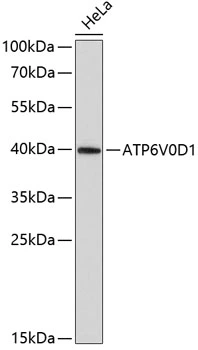
WB analysis of HeLa cell lysate using GTX66439 ATP6V0D1 antibody. Dilution : 1:2000 Loading : 25microg per lane
ATP6V0D1 antibody

GTX66439
Overview
- SupplierGeneTex
- Product NameATP6V0D1 antibody
- Delivery Days Customer9
- ApplicationsWestern Blot
- CertificationResearch Use Only
- ClonalityPolyclonal
- ConjugateUnconjugated
- Gene ID9114
- Target nameATP6V0D1
- Target descriptionATPase H+ transporting V0 subunit d1
- Target synonyms32 kDa accessory protein; ATP6D; ATP6DV; ATPase, H+ transporting, lysosomal (vacuolar proton pump), member D; ATPase, H+ transporting, lysosomal 38kDa, V0 subunit d1; H(+)-transporting two-sector ATPase, subunit D; P39; vacuolar proton pump subunit d 1; V-ATPase 40 KDa accessory protein; V-ATPase AC39 subunit; V-ATPase subunit d 1; V-ATPase, subunit D; VATX; VMA6; VPATPD; V-type proton ATPase subunit d 1
- HostRabbit
- IsotypeIgG
- Scientific DescriptionThis gene encodes a component of vacuolar ATPase (V-ATPase), a multisubunit enzyme that mediates acidification of eukaryotic intracellular organelles. V-ATPase dependent organelle acidification is necessary for such intracellular processes as protein sorting, zymogen activation, receptor-mediated endocytosis, and synaptic vesicle proton gradient generation. V-ATPase is composed of a cytosolic V1 domain and a transmembrane V0 domain. The V1 domain consists of three A and three B subunits, two G subunits plus the C, D, E, F, and H subunits. The V1 domain contains the ATP catalytic site. The V0 domain consists of five different subunits: a, c, c, c, and d. Additional isoforms of many of the V1 and V0 subunit proteins are encoded by multiple genes or alternatively spliced transcript variants. This encoded protein is known as the D subunit and is found ubiquitously. [provided by RefSeq, Jul 2008]
- ReactivityHuman
- Storage Instruction2°C to 8°C,-20°C or -80°C
- UNSPSC12352203
